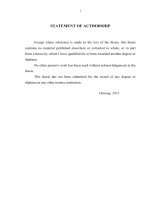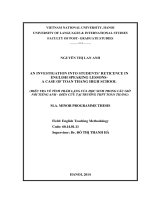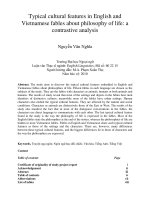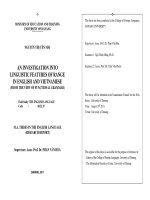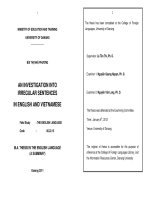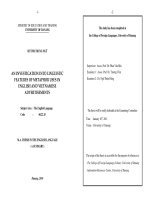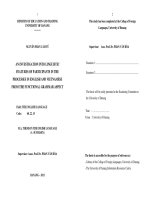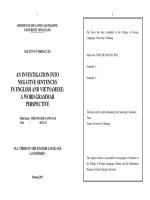An investigation into linguistic features in advertising slogans of cosmetic products in english and vietnamese
Bạn đang xem bản rút gọn của tài liệu. Xem và tải ngay bản đầy đủ của tài liệu tại đây (412.54 KB, 26 trang )
MINISTRY OF EDUCATION AND TRAINING
THE UNIVERSITY OF DANANG
LÊ LÊ LỘC UYỂN
AN INVESTIGATION INTO LINGUISTIC
FEATURES IN ADVERTISING SLOGANS
OF COSMETIC PRODUCTS
IN ENGLISH AND VIETNAMESE
Field Study: The English Language
Code: 60.22.02.01
MASTER THESIS IN SOCIAL SCIENCES
AND HUMANITIES
(A SUMMARY)
Danang - 2014
The study has been completed at College of Foreign Languages,
THE UNIVERSITY OF DANANG
Supervisor: Assoc.Prof.Dr. PHAN VĂN HÒA
Examiner 1: Truong Bach Le
Examiner 2: Nguyen Van Long
The thesis was orally defended to the Examining Council
at the University of Danang
Time: December, 2014
Venue: University of Danang
The thesis is accessible for purpose of reference at:
- Library of the College of Foreign Language, Danang
- Danang University Information Resources Centre
1
CHAPTER 1
INTRODUCTION
1.1. RATIONALE
Along with the rapid development of social economy,
advertising has penetrated every corner of society. People are
exposed to numerous advertising messages every day. To
compete with many other products, advertisers use various
devices to catch customers’ attention, arouse their desire and
induce their action. Slogans can be considered the heart of
advertisements. They are the most important and condensed
messages advertisers would like to send to their customers.
Catchy and creative slogans can help advertisers leave
unforgettable impressions on their potential customers’ minds.
However, the advertising time is limited and every minute is
measured by money. As a result, how to make the
advertisement persuasive but concise is the big problem
confronted by advertisers. The successful advertiser must know
how to integrate the brand and slogan in such a way that the
slogan can strengthen branding, or have some other effect.
For example, Maybelline has a slogan “Maybe she’s
born with it- maybe it’s Maybelline.” The repeated words
“maybe” can make the slogan more readable and memorable.
Or E100 “Ôi! Làn da trắng mịn như bông.” has a really strong
influence on those who wish to have a smooth and fair
complexion.
Just a few words in a slogan, advertisers must convey
necessary information to customers, which must be hard work
for them. It requires a sophisticated linguistic insight of
2
phonology, lexicology, syntax as well as semantics and
pragmatics. Therefore, the study of some successful slogans
promises a lot of interesting facts in the art of using language
among advertisers.
I decide to choose the topic “The Linguistic Features in
Advertising Slogans of Cosmetic Products in English and
Vietnamese” to investigate in this study for two main reasons.
First of all, as a woman, I want to get information about
cosmetics to make myself better and help others with necessary
knowledge so that they can make themselves look more
attractive. Second, the investigation into those slogans will
hopefully reveal interesting features in language used in
slogans in general and cosmetic slogans in particular and,
therefore, it will provide certain linguistically useful practical
knowledge for advertisers, especially in cosmetics. For these
reasons, I wish to carry out my research on the topic “An
Investigation into Linguistic Features in Advertising Slogans of
Cosmetic Products in English and Vietnamese”.
1.2. SCOPE OF STUDY
The study is mainly about the investigation into
advertising slogans of cosmetics brands. Lexical, syntactic and
stylistic features of the advertising slogans in cosmetics are
extensively discussed in this study.
1.3. AIMS AND OBJECTIVES
1.3.1. Aims
The aim of the research is to analyze linguistic features
of advertising slogans in cosmetics so as to find out some hints
for Vietnamese advertisers, especially in cosmetics, which may
3
help to improve their effectiveness and professionalism.
1.3.2. Objectives
In order to achieve the aims mentioned above, the
research is intended to carry out the following objectives:
- To analyze the linguistic features in advertising slogans of
cosmetic products in English and Vietnamese.
- To find out the differences and similarities of advertising
slogans in cosmetic products between English and Vietnamese.
- To suggest some applications for teachers and learners of
English, as well as for those who are interested in advertising to
learn and comprehend English copywriters’ methods in writing
effective advertising slogans especially in cosmetics.
1.4. RESEARCH QUESTIONS
To achieve the aims and objectives of the study, the
research questions below must be answered:
- What are lexical, syntactic and stylistic features of the
advertising slogans in cosmetics in English and Vietnamese?
- What are the similarities and differences of advertising
slogans in cosmetics between English and Vietnamese?
- What are the implications for teaching and learning in both
languages?
1.5. ORGANIZATION OF THE STUDY
The study is organized into five chapters as follows:
Chapter 1: Introduction
Chapter 2: Literature
Review
and
Theoretical
Background
Chapter 3: Methods and Procedures
Chapter 4: Findings and Discussion
4
Chapter 5:
Conclusions and Implications
1.6. SIGNIFICANCE OF THE STUDY
The values of the study lie in both theoretical and
practical aspects. Theoretically, the study helps to find out the
linguistic features used in cosmetic slogans. Practically, it helps
to find out the effectiveness of those linguistic features when
applying to the act of advertising and hopefully suggests some
ways of achieving great impression on customers’ minds
through the art of using words by advertisers.
CHAPTER 2
LITERATURE REVIEW AND THEORETICAL
BACKGROUND
2. 1. A REVIEW OF PREVIOUS STUDIES
Up to now, there have been several studies on
advertising, advertising slogans in English and Vietnamese.
Some famous titles that can be mentioned here are “English in
advertising: A linguistic study of advertising in Great Britain”
by Geoffrey (1996), “Advertising as communication” by
Gillian (1982), “English for sale: A study of the language of
advertising” by Lars (1999), or “The discourse of advertising”
by Guy (2001). Besides, there have been many master theses
related to advertising slogans in cosmetics such as: Nguyen
Dinh Thuy An (2012), “A study of lexical, syntactic and
pragmatic features of company slogans in English and
Vietnamese”, this research focuses on lexical, syntactic and
pragmatic features in English and Vietnamese slogans of
production and service companies. Truong Thi Phuong
5
investigated advertising slogans in English and Vietnamese.
Ho Vi Nu Dieu Minh (2011), “A discourse analysis of English
and Vietnamese advertisements for beauty care products”
finds out the features in terms of the layout, lexis, syntax
features and cohesive devices as well as discover similarities
and differences of these features between the two languages.
Lê Thị Kim Yến (2010) in an article “Ý nghĩa ngữ dụng của
một số biện pháp tu từ trong khẩu hiệu quảng cáo tiếng Anh và
tiếng Việt” indicates pragmatic meanings of some rhetorical
devices in English and Vietnamese advertising slogans. All
these help me a lot in understanding advertising slogans clearly
so that I could apply them to this thesis.
However, little discussion of advertising slogans in
cosmetics is investigated. I hope that this thesis “An
Investigation into Linguistic Features in Advertising Slogans of
Cosmetic Products in English and Vietnamese” will contribute
a minor part to yield fruitful information of this field.
2.2. THEORETICAL BACKGROUND
2.2.1. Definition of terms
a. Definition of advertising
Advertising is a means of promotion the product, idea,
or organization on the market with the aim to give information
and to persuade people of the advantage of the product and
induce them to take an action (e.g. buy it).
b. Definition of advertising slogan
A slogan is a memorable motto used in political,
commercial, religious, and other contexts as a repetitive
expression of an idea or purpose. In the particular case of an
6
advertising slogan, it is a verbal logo normally appearing just
beneath or beside the brand name or the logo of the product. A
slogan is a kind of a condensed message of the whole
advertisement which advertisers want their customers to
remember most. It is the usual case that slogans come to
customers’ mind first when they think about the products.
c. Definition of cosmetic
According to Oxford Advanced Learner’s Dictionary
(2009) [21], cosmetic is a substance that you put on your face
or body to make it more attractive.
In the U.S., the Food and Drug Administration (FDA),
which regulates cosmetics, defines cosmetics as "intended to be
applied to the human body for cleansing, beautifying,
promoting attractiveness, or altering the appearance without
affecting the body's structure or functions." This broad
definition also includes any material intended for use as
a component of a cosmetic product. The FDA specifically
excludes soap from this category.
2.2.2. Defining the concept of advertising and
advertising slogan
a. History of advertising
b. Types of advertising
c. Function of Slogan in Advertising
d. Principles in Writing Slogans
e. Requirements of a Good Slogan
2.2.3. Advertising as kind of communication
a. The process of communication
b. Verbal and non-verbal communication in
7
advertising
c. Public versus word-of-mouth
communication of advertising
2.3. LINGUISTIC FEATURES IN ADVERTISING
SLOGANS OF COSMETIC PRODUCTS
2.3.1. Phonological features
In order to make the slogan more noticeable and
memorable, advertisers play with the sounds within the
utterance to create euphony. Among these features are rhyme
and alliteration.
a. Use of rhyme
b. Use of alliteration
2.3.2. Lexical features
a. Common uses of second person addressee
“you”, “we”, “us”
b. Use of unqualified comparison
c. Use of “every”, “always”, etc.
d. Use of “no”, “none”, etc.
e. Use of coined words
2.3.3. Syntactic features
a. Use of short simple sentences
b. Use of everyday sentences
c. Use of phrases
d. Use of questions
e. Use of imperative sentences
f. Use of tense
g. Creative use of idioms or proverbs
2.3.4. Semantic features
8
Each linguistic expression has its literal meaning.
Literal meaning denotes what it means according to common
or dictionary usage (or more exactly, what “the reader is most
likely to assign to a word or phrase if he or she knows nothing
about the context in which it is to be used.” [51] The same
linguistic expression, however, may have also its figurative
meaning. For example, the word “professional” has
connotations of skill and excellence. It is not possible to give
an exhaustive account of the connotations of the expression,
because connotative meanings, which have been evoked in an
individual, depend on people’s entire previous experiences and
on conventions of community. Therefore, the connotations of
the same expression will differ slightly from person to person.
Furthermore, the same denotations can have different
connotations in different context. In advertising slogan
language, the most frequent word for “acquisition of product”
is “get”, and not “buy”, because “buy” has some unpleasant
connotations, like “money” and the parting with it.
In advertising slogans, copywriters tend to use tropes. A
trope is “a word or phrase that is used in a way that is different
from its usual meaning in order to create a particular mental
image or effect.” [21] It is a figurative expression. In this part,
we give a list of most important tropes used in advertising
slogan language: ambiguity in captions, personification, simile,
hyperbole, metaphor and metonymy. In relation to semantic
aspect of language, we define also antithesis, polysemy, and
homonymy.
a. Ambiguity in Captions
9
b. Personification
c. Simile
d. Hyperbole
e. Metaphor
f. Metonymy
g. Antithesis
h. Polysemy and homonymy
2.3.5. Concluding Remarks
The theoretical part provides the definition of
advertising and describes it as a type of communication. The
most frequent linguistic devices used in slogans have been
identified and, consequently, described in relation to the
advertising objectives. The practical part relies on the findings
of the theoretical part to analyze the advertising slogans and
identify the patterns of their occurrence in the studied slogans.
The corpus of slogans is divided into three thematic categories
and the practical part establishes the connection between the
choice of linguistic devices used in slogans and the thematic
category to which the advertisements were assigned. The
analysis confirms the proposition that copywriters rely on
language, using it in order to make the slogans accomplish their
main function: make the customer be enticed by the particular
product or idea advertised. The most frequent linguistic devices
employed in slogans are identified and present: heavy use of
the personal pronoun you, ellipsis, alliteration, imperative
sentence type, puns, and personification.
It has been also observed that the frequency of
occurrence of the rhetorical devices does not depend on the
10
category and is distributed evenly throughout the whole corpus
of analyzed samples. However, the choice of the particular
rhetorical figures demonstrates the dependence on the
advertising category: alcohol and cigarettes advertising tends to
use descriptive language with metaphors, personification; noncommercial advertising employs high number of personal
pronouns in order to establish a closer connection with the
audience and call people to action; unspecified advertising of
various products stands out with its high number of
imperatives, which is explained by its persuasive function.
The results of the research carried out in this thesis may
serve as a basis for further studies that lays a foundation for the
investigation to be made in chapter 4.
CHAPTER 3
METHODS AND PROCEDURE
3.1. RESEARCH DESIGN
This study uses a combination of both qualitative and
quantitative methods. The reasons for this combination lie in
the procedures of the study. First of all, the slogans are
investigated so that linguistic features appearing in them are
discovered and named. Next, to find out which feature is the
most commonly-used in cosmetic adverting slogans, the
quantitative method is employed through systemizing the
frequency of the occurrence of each feature in different tables.
Some complementary methods used in this study include
studying some specialist knowledge in advertising, getting to
know the economic, social and cultural factors that have
influence on the issue investigated as well as personal
11
observation.
3.2. DATA COLLECTION
100 collected advertising slogans in cosmetics in each
language are used to investigate the similarities and differences
in linguistic features. They are mainly taken from the Internet,
magazines and newspapers.
3.3. DATA ANALYSIS
The findings of the similarities and differences in some
linguistic features in English and Vietnamese advertising
slogans in cosmetics will be presented from the descriptive and
contrastive analysis. The data will be quantitatively analyzed
and presented to show the frequency of those linguistic features
from which I work out the proportion of slogans using each
feature to find out the prevailing trends among the cosmetics
slogans.
3.4. RESEARCH PROCEDURES
The procedures for the study will be as follows:
- Collecting advertising slogans in cosmetics in two
languages.
- Choosing and classifying the advertising slogans in
cosmetics and arranging them into groups which have same
category to put into analysis.
- Analyzing those advertising slogans in cosmetics to find
out the most prominent feature of each group.
- Making a contrastive analysis to find out similarities and
differences in syntactic, semantic, phonological and lexical
features advertising slogans in cosmetics in English and
Vietnamese.
12
- Comparing the similarities and differences between
advertising slogans in cosmetics in English and Vietnamese as
the findings of the research and explaining the factors affecting
the similarities and differences between them.
- Drawing conclusions and giving some suggestions for
further research.
3.5. RELIABILITY AND VALIDITY
The quality of the data in this study is reliable for the
fact that all advertising slogans of cosmetics in English and
Vietnamese are totally collected from the most popular and
prestigious newspapers, magazines, TV and websites.
The result of the study not only provides the theoretical
background for carrying out the research into the linguistic
features of advertisements in general, but also considerably
contributes to the teaching and learning linguistic features of
advertising slogans of cosmetics in English and Vietnamese in
particular.
CHAPTER 4
FINDINGS AND DISCUSSION
4.1. LEXICAL FEATURES OF COSMETIC SLOGANS
4.1.1. The Use of Monosyllabic Verbs
4.1.2. The Use of Weasel Words
4.1.3. The Use of Favorable Words
a. The Use of Adjectives
b. The Use of Comparative and Superlative
Degrees
4.1.4. The Use of Personal Pronouns
13
Table 4.1. Frequency of Lexical Features of Cosmetic
Advertising Slogans in English and Vietnamese
English
Vietnamese
Lexical Features
Number Percent Number Percent
26
28.9
5
6.0
Monosyllabic Verbs
9
10.0
8
9.6
Weasel Words
30
33.3
48
57.8
Adjectives
Comparative
Favorable
and
Words
5
5.6
12
14.5
Superlative
Degrees
20
22.2
10
12.1
Personal Pronouns
Total
90
100%
83
100%
From Table 4.1, there are 90 English advertising
slogans and 83 Vietnamese advertising slogans contributing to
the Frequency of Lexical Features. In both languages,
Adjectives predominate in English with 33.3% and Vietnamese
with 57.8%. Monosyllabic Verbs in English rank the second
with 28.9%. In Vietnamese, Comparative and Superlative
Degrees rank the second with 12 samples (14.5%) and the
third position belongs to Personal Pronouns with 20 samples
(22.2%) in English and 10 samples (12.1%) in Vietnamese. In
English, Comparative and Superlative Degrees with take the
last position with 5 samples (5.6%) while in Vietnamese, the
last position belongs to Monosyllabic Verbs with 5 samples
(6.0%).
14
It can be seen that Adjectives are the most favorable
words in cosmetic advertising slogans. English copywriters
prefer Monosyllabic Verbs because they can easily be
understood by a wide range of readers whereas Vietnamese
ones are inclined to use Comparative and Superlative Degrees
with the reason is that they want to use comparative to indicate
the excellent quality of their product or service.
4.2.
SYNTACTIC FEATURES
OF
COSMETIC
SLOGANS
4.2.1. Verb Phrase
4.2.2. Noun Phrases
4.2.3. The Use of Imperative and Declarative mood
4.2.4. The Use of Short Sentences
4.2.5. The Use of Simple Sentences
4.2.6. The Use of Elliptical Sentences
Table 4.2. Frequency of Syntactic Features of Cosmetic
Advertising Slogans in English and Vietnamese
English
Vietnamese
Syntactic
Features
Number Percent Number Percent
30
13.0
38
16.5
Verb Phrase
20
8.7
12
5.2
Noun Phrases
Imperative and
26
11.3
10
4.3
Declarative mood
32
13.9
39
17.0
Short Sentences
42
18.3
46
20.0
Simple Sentences
Elliptical
80
34.8
85
37.0
Sentences
Total
230
100%
230
100%
15
It can be seen from Table 4.2, Elliptical Sentences in
both English and Vietnamese advertising slogans take the first
position with 34.8% and 37.0% respectively. Simple Sentences
rank the second with 18.3% in English and 20.0% in
Vietnamese and the third position is Short Sentences with
13.9% in English and 17.0% in Vietnamese. Also, such
Syntactic Features as Verb Phrase, Noun Phrases and
Imperative and Declarative mood are also found in English or
Vietnamese advertising slogans.
It can be interpreted that Elliptical Sentences dominate
in cosmetic advertising slogans because ellipsis can make
sentences short, concise, emphasize the key words, and avoid
redundancy. Moreover, short and simple sentences are
preferred. The reason is that short and simple sentence is
concise that can create emphasizing effect on the advertising
slogan, making it easy to memorize.
4.3. SOME STYLISTIC DEVICES USED IN COSMETIC
SLOGANS
4.3.1. Repetition
4.3.2. Hyperbole
4.3.3. Rhetorical Questions
4.3.4. Rhyme
4.3.5. Parallelism
16
Table 4.3. Frequency of Stylistic Features of Cosmetic
Advertising Slogans in English and Vietnamese
English
Vietnamese
Stylistic
Features
Number
Percent
Number
Percent
6
16.7
9
24.3
Repetition
16
44.4
15
40.5
Hyperbole
Rhetorical
3
8.3
0
0
Questions
5
13.9
7
18.9
Rhyme
6
16.7
6
16.3
Parallelism
Total
36
100%
37
100%
Table 4.3 shows that in both languages, Hyperbole
predominate with 44.4% in English and 40.5 in Vietnamese. It
can be explained that hyperbole is an essential part in cosmetic
advertising slogans because all typewriters want to describe
their products by making them sound bigger, smaller, better
and so on than they really are. The second popular Stylistic
Features is Repetition with 6 samples 16.7% in English and 9
samples 24.3% in Vietnamese because producers want to repeat
words or sentences naturally to stress an important message or
indicate a strong feeling. Rhyme and Parallelism are also used
as Stylistic Features in cosmetic advertising slogans. However,
Rhetorical Questions are used least with 3 samples 8.3% in
English but in Vietnamese, there is no this Stylistic Feature.
In conclusion, repetition, hyperbole, rhetorical
questions, rhyme and parallelism of stylistic devices in
cosmetic advertising slogans have strong value to reveal the
product features and characteristics with impressive, attractive,
17
outstanding expression to customers.
All the above – mentioned stylistic features of cosmetic
advertising slogans are necessary to make them neat, simple,
original, strategic, memorable and companionable. The slogans
are also a kind of poetic language, which we should pay
attention to.
4.3.6. Conclusion
To sum up, repetition, hyperbole, rhetorical questions,
rhyme and parallelism of stylistic devices in English cosmetic
slogans have strong value to reveal the product features and
characteristics with impressive, attractive, outstanding
expression to customers. All the above – mentioned stylistic
features of cosmetic slogans are necessary to make them neat,
simple, original, strategic, memorable and companionable. The
slogans are also a kind of poetic language, which we should
pay attention to. In order to make the advertising slogans more
special and memorable, copywriters must pay much attention
to the stylistic devices.
4.4.
SIMILARITIES
AND
DIFFERENCES
IN
LINGUISTIC
FEATURES
OF
COSMETIC
ADVERTISING SLOGANS IN ENGLISH VERSUS
VIETNAMESE
4.4.1. Similarities and Differences in Lexical
Features
There are some similarities in the semantic features of
cosmetic advertising slogans in English versus Vietnamese
which are shown as follows: Firstly, both English and
Vietnamese cosmetic advertising slogans use the same lexical
18
items such as comparative and superlative degrees, first and
second personal pronouns, weasel words and so on. Secondly,
English and Vietnamese cosmetic advertising slogans are
characterized by an extensive use of modifying adjectives and
adverbs contributing to the persuasive effect of advertising
purpose. The technique leads to an introduction of a large
number of good, memorable, concise and user-friendly slogans.
However, slogans in each language contain their own
distinctive features. Slogans in English are often shorter than in
Vietnamese because English cosmetic slogans tend to use
monosyllabic verbs. Besides, English slogans contain more
omitted elements such as determiners, linking verbs, auxiliary
verbs and even subjects.
4.4.2. Similarities and Differences in Syntactic
Features
Some similarities in the syntactic features of cosmetic
English and Vietnamese advertising slogans are withdrawn as
follows: Firstly, both English and Vietnamese advertising
slogans share the same syntactic patterns such as the sentences
used in both kinds of slogans are often short, simple and minor.
This is because advertising slogans in forms of simple
sentences are much easier for customers to remember thanks to
their shortness and simplicity. The complex and compound
sentences, on the other hand, are often long and complicated
which may cause difficulties in memorizing the slogans. In
cosmetic advertising slogans, advertisers often use imperative
and declarative mood. Statements are common and negations
are seldom used.
19
However, each language has its own distinctive
syntactic features. Firstly, noun phrases appear in English
cosmetic advertising slogans more in Vietnamese cosmetic
advertising slogans while verb phrases takes up the higher
proportion in Vietnamese advertising slogans. It can be
explained that English people tend to use nominal phrases
whereas Vietnamese people prefer the verbal phrases.
Secondly, in the use of elliptical sentences, English copywriters
prefer a group of sentence fragments whereas Vietnamese ones
nearly don’t use this kind of fragments.
4.4.3. Similarities and Differences in Stylistic
Features
Like lexical and syntactic features, there are also some
similarities in the stylistic features of cosmetic advertising
slogans in English and Vietnamese. Advertisers tend to use
rhetorical devices to appeal interest and surprise to customers.
Repetition, hyperbole, rhetorical questions and rhyme are quite
common. Rhetorical devices in advertisement help producers
attract their consumers’ attention and persuade them into
buying their products. In cosmetic slogans, advertisers
frequently use hyperbole to evoke strong feelings or to attract
customers, not with the facts about their products but with wild
exaggerations. It could make the advertising lively and give a
vivid impression to the customer. Pun, leaves a deep
impression on readers by its readability, wit and humor.
Advertisers use repetition to stress the unique sales proposition
of the advertised product, establish your credibility or set up
brand familiarity.
20
However, English Cosmetic Advertising Slogans and
Vietnamese Cosmetic Advertising Slogans have some
differences in stylistics devices in its own language. Firstly,
repetition takes a high frequency in both languages, Lastly,
hyperbole is widely used in the two languages with the same
purpose of exaggerating the product and luring customers.
Nevertheless, hyperbole is more favorable in English cosmetic
slogans, whereas in Vietnamese, the number of percentage take
less proportion.
CHAPTER 5
CONCLUSIONS AND IMPLICATIONS
5.1. CONCLUSIONS
In this study, 200 cosmetic adverting slogans (100 in
each language) have been investigated to find out the mostlyshared characteristics in the English language employed by the
most famous cosmetic brands in the world and in our country.
The investigation has helped the author to draw some
conclusions which will obviously be appreciated by cosmetic
advertisers.
- As to lexical features, some monosyllabic verbs such as
get, be, find, bring, give, make, shine, feel …are often
used. These short words can hit the goals in the shortest
time. In terms of pronouns and possessive determiners,
“you” and “yours” become the two most frequently
used ones among all the pronouns and determiners
appearing in one. In the use of favourable words,
English copywriters prefer the adjectives “fresh, clean,
natural, healthy, smooth, new” to talk about their
21
-
-
products while in Vietnamese cosmetic adverting
slogans, such adjectives as “nhẹ nhàng, quyến rũ, đẹp,
sang trọng, tươi trẻ” are preferable. Nearly half of the
slogans selected for analysis choose adjectives as a
means to enhance the effectiveness and there also
appears a wide variety of adjectives appearing in the
samples.
In the syntactic aspect, phrases are mostly used by
cosmetic admen, probably due to the requirement of
conciseness in slogans. This requirement also explains
the fact that short simple sentences, imperative
sentences and short questions are very popular in
cosmetic slogans. Affirmative sentences and noun
phrases are often used because they are easy for
consumers to remember. Some of the short sentences
are elliptical sentences. Elliptical sentences are used to
spare advertising cost and at the same time improve
advertising effectiveness. Besides, the use of nouns as
brand names comes after the use of verbs. They help to
make the customers remember the products or services
well.
In terms of stylistic devices, a large number of slogans
use rhymes and recalling the brand name as a means to
make their slogans memorable. Nouns are widely used
as brand names. They help to make the consumers
remember the products or services and deliver the
information very well. Repetition is often used in
cosmetic advertising slogans. It can also lead to
22
understanding, as it gives time for the penny to drop.
This is important for companies bringing innovative
new products to the market where users may initially
unfamiliar with the product or its usage. Besides, the
use of exaggerated statements, hyperbole, puts
emphasis on the particular features of the products or
services, or sometimes achieves humorous effect.
Moreover, to make the slogans catchy and memorable,
such stylistic devices as rhetorical questions, rhyme,
parallelism are often used in cosmetic advertising
slogans.
5.2. IMPLICATIONS FOR THE USE OF LANGUAGE IN
CREATING COSMETIC SLOGANS IN VIETNAM
5.2.1. Implications for Teachers
There are a number of benefits this thesis brings to the
teachers. It will help teachers with the teaching materials of
lexical, syntax and stylistic features in general and in
advertising slogan language in particular. Cosmetics play an
important part in beauty industry and a good cosmetic
advertising is one of the best ways to attract customers. With
this thesis, teachers will have a good knowledge of the
contrastive analysis between English and Vietnamese of
cosmetic advertising slogans in linguistic features. Moreover, it
also gives explanations to these similarities and differences
basing on the tendency of business strategies and cultural
features of the two languages. Therefore, teachers can help
students to create persuasive and catchy advertising slogans in
general and those for cosmetic in particular.
23
5.2.2. Implications for Learners
The result of this study will help the learners of English
and Vietnamese with the useful knowledge of the contrastive
analysis of cosmetic advertising slogans in Vietnamese and in
English in terms of the lexical, syntactic and stylistic devices.
Moreover, learners can also benefit from the understanding
distinctive features of English and Vietnamese advertising
slogans. As a result, they can enhance their skills of writing
efficient advertising slogans for cosmetic as well as for other
fields in English and Vietnamese.
5.3. LIMITATIONS AND DELIMITATIONS
In order to conduct the study in time, the focus has been
restricted to the investigation into lexical, syntactic, and
stylistic features of advertising slogans in cosmetics in English
and Vietnamese. In fact, there are other linguistic devices that
are not fully mentioned here. Therefore, the findings of the
study will not generalize over all advertising slogans in
cosmetics in English and Vietnamese as a whole. However,
they can be expected to contribute useful knowledge to the art
of using words by advertisers in writing advertising slogans
especially in cosmetics.
5.4. SUGGESTIONS FOR FURTHER RESEARCHES
This study has attempted to investigate the lexical,
syntactic and stylistic features of cosmetic advertising slogans
in English and Vietnamese and has come out with the most
popular linguistic features in advertising slogan language.
However, due to the limitations of time and knowledge, this
study has only investigated 200 cosmetic slogans (100 in each
